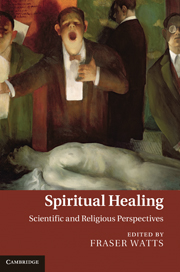Book contents
- Frontmatter
- Contents
- List of figures
- List of contributors
- Preface
- 1 Conceptual issues in spiritual healing
- 2 The historical Jesus and healing: Jesus' miracles in psychosocial context
- 3 The theology of spiritual healing
- 4 Healing the spirit: mystical Judaism, religious texts and medicine
- 5 Conceptualizations of spiritual healing: Christian and secular
- 6 The psychodynamics of spiritual healing and the power of mother kissing it better
- 7 Spiritual healing in the context of the human need for safeness, connectedness and warmth: a biopsychosocial approach
- 8 Modelling the biomedical role of spirituality through breast cancer research
- 9 Spirituality and health: assessing the evidence
- 10 Relating spiritual healing and science: some critical reflections
- 11 Concluding integration
- Bibliography
- Index
7 - Spiritual healing in the context of the human need for safeness, connectedness and warmth: a biopsychosocial approach
Published online by Cambridge University Press: 04 February 2011
- Frontmatter
- Contents
- List of figures
- List of contributors
- Preface
- 1 Conceptual issues in spiritual healing
- 2 The historical Jesus and healing: Jesus' miracles in psychosocial context
- 3 The theology of spiritual healing
- 4 Healing the spirit: mystical Judaism, religious texts and medicine
- 5 Conceptualizations of spiritual healing: Christian and secular
- 6 The psychodynamics of spiritual healing and the power of mother kissing it better
- 7 Spiritual healing in the context of the human need for safeness, connectedness and warmth: a biopsychosocial approach
- 8 Modelling the biomedical role of spirituality through breast cancer research
- 9 Spirituality and health: assessing the evidence
- 10 Relating spiritual healing and science: some critical reflections
- 11 Concluding integration
- Bibliography
- Index
Summary
Healing is a term that captures the concepts of recovery or repair from dysfunction and/or injury. However, it only applies to ‘living things’ (we ‘mend’ or ‘fix’ rather than ‘heal’ the car), and refers to processes occurring in physical bodies, minds and relationships. The scientific study of healing is linked to theories and ‘knowledge’ of what causes dysfunction or injury, and the mechanisms underpinning recovery, repair and healing. Cultures vary greatly on both counts. For example, Nisbett et al. (2001) pointed out that collective societies focus on social relationships, and see the world in terms of patterns and the interconnected nature of things. Healing practices involve focusing on relationships between people, relationships of inner forces (for example yin and yang) and restoring inner balance in ‘energies/processes’ as a holistic approach. In contrast, in the more individualist and Western science-focused societies, there is concern to split and segregate things into individual categories and units, such as ‘disease entities.’ These are seen as having their own individual, autonomous characteristics, to be treated with the application of specific technologies (for example drugs and surgery), and evaluated in research trials.
A similar dichotomy was prevalent in early Greek medicine. The Hippocratic School focused on holistic medicine, the processes of becoming ill, personality and the contexts and life events and circumstances of the illness – a basic biopsychosocial approach.
- Type
- Chapter
- Information
- Spiritual HealingScientific and Religious Perspectives, pp. 112 - 127Publisher: Cambridge University PressPrint publication year: 2011



